Tomato plant wilting? You need to do this now!
As an Amazon Associate and member of other affiliate programs, I earn from qualifying purchases.
You don’t have to be an expert gardener to recognize that it’s a bad sign to find your tomato plant wilting. The downward drooping leaves are certainly an indication that something is wrong.
When you see a tomato plant wilting, you’re left wondering:
Is it just thirsty or does it have a disease?
In some cases, you just need to adjust your watering schedule and your plant will be fine. But sometimes, wilting is a symptom of infectious disease that can ruin your entire crop. There are some clues that can help you distinguish between them, and in this post, I’m going to go over the causes of tomato wilt and what you need to do to help your plant recover.
What causes tomato plant wilting?
Tomato wilt is a symptom of dis-ease that makes the tomato plant leaves droop and lose their shape. Wilting is most commonly a sign that your plants need water, and all plants will respond this way to dehydration. If the soil is dry and your plant is droopy with flat, thin leaves, you probably just need to water it. It should recover, but if it got too dry or this happens very often, don’t expect a good crop off of that plant.
On the flip side, too much water can cause wilting of plants. In this case, the soil around the plant will be wet and the leaves will droop but stay hydrated. Let the plant dry out and watch it for the next couple of days to see how it does. Don’t water again until the top inch of soil is dry. Container plants will also need some fertilizer as nutrients were likely washed out with the overwatering.
Pro Tip:
Watering tomato plants is a balancing act. Tomatoes need even moisture, and they don’t respond well to periods of dry or soggy soil. Water stress can lead to problems like tasteless fruit, blossom end rot, and cracking and even facilitate the spread of disease.
Other environmental causes of wilt in tomato plants
Tomatoes that experience a frost will wilt and not recover. The freezing of the water in their cells causes them to burst thus killing the plant. Also, certain trees like the black walnut, will stunt the growth and cause wilting of many plants including tomatoes. It is recommended not to plant under or near a walnut tree. If you’re looking at your wilted plant and there’s not an environmental issue causing wilt, then you might be dealing with one of the infectious causes of wilt.
Infectious causes of tomato wilt
When experienced gardeners and farmers talk about wilt, they are often talking about an infectious disease. Tomato wilt can be caused by many types of viral, bacterial, and fungal infections that can infect and destroy your entire crop. That’s why it’s very important to determine whether your plant is having a physiological response to stress or it’s come down with a sickness and you need to get it out of your garden asap.
There are several common causes of infectious wilt:
Tomato spotted wilt virus
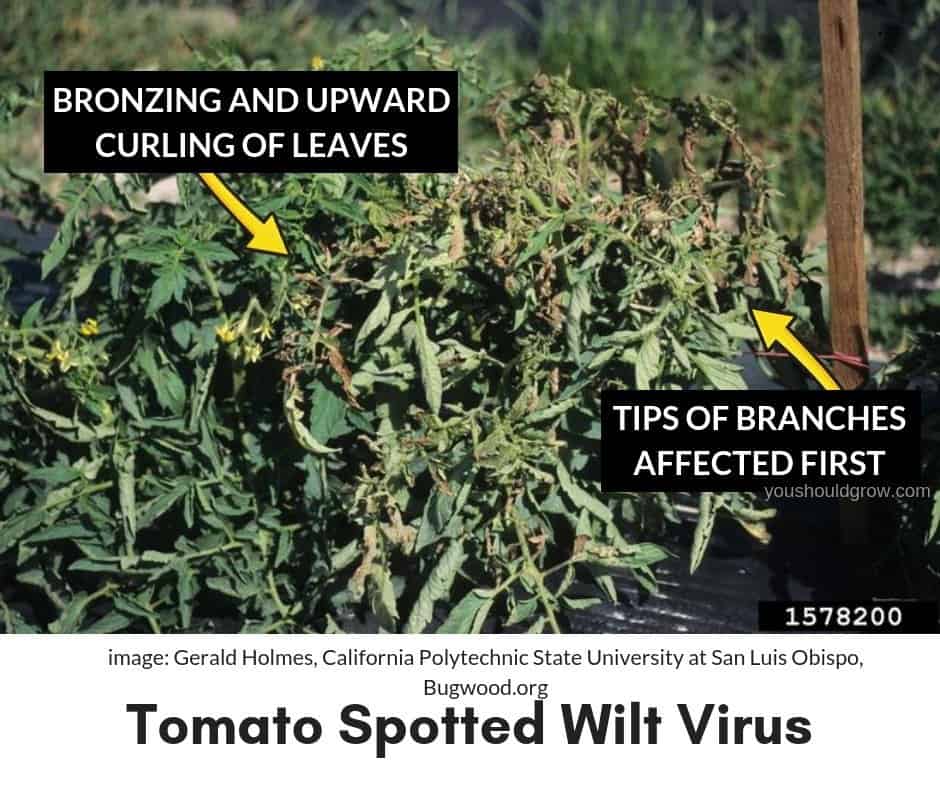
Tomato spotted wilt virus is an infection that is can be seen worldwide. This viral infection is transmitted by several species of thrips which are tiny biting insects that find hosts on tomatoes and many other plants.
TSWV is not a disease of just tomatoes, but can also be found on peppers, potatoes, and several other flower and weed species. Symptoms vary by strain of virus, species of plant infected, and age of plant infected.
On tomatoes, symptoms usually appear on the youngest/growing portions of the plant. While signs of infection vary on a case by case basis, plants usually exhibit one or more of the following symptoms:
- Leaves turn a brown/bronze color and may curl upward
- Leaves can get clusters of small black spots
- Wilting and death of the growing portions of the plant.
- Both green and ripe fruit are lumpy with ring-shaped marks
Unfortunately, there is no way to treat infection with TSWV and infected plants should be culled and burned or tossed into the trash. You can send your plant for testing at your local university extension service if you want a firm diagnosis.
To prevent the spread, you really need to focus on getting rid of the thrips. If I knew they were spreading TSWV, I would skip all the horticultural oils and treat instead with either PyGanic or Naturalyte. Both of which are organic approved pesticides.
My preference is for Naturalyte because the active ingredient, spinosad, has no residual effect on pollinators, but PyGanic is a sure bet to get rid of your pest problem. In either case, avoid spraying when bees and other pollinators are active.
Fusarium wilt
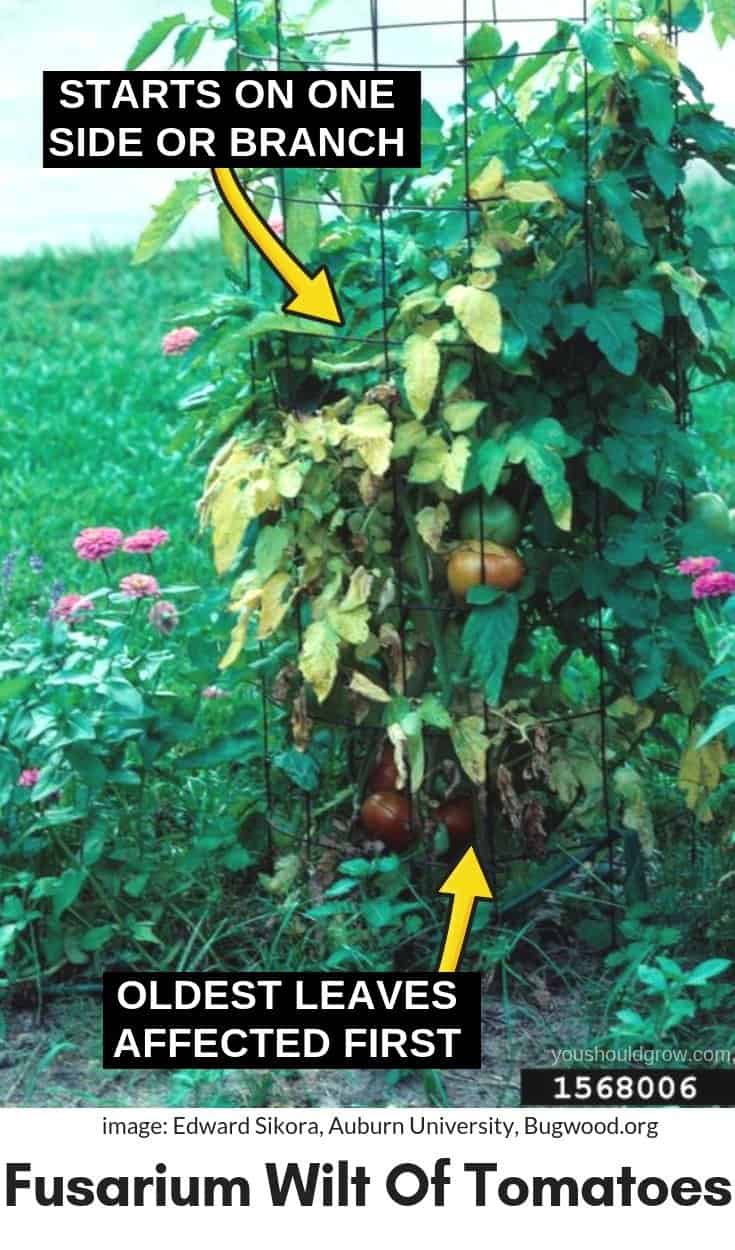
Fusarium wilt is a fungal infection common in areas with warm, moist weather. The fungus lives in the soil and enters the plants via their root system.
As it spreads, it grows up the inside of the tomato plant to the stem and branches via the vascular system. This clogging of its vascular system is what causes the symptoms of wilting and stunted growth. You’ll first notice the lower leaves turn yellow and start to die. Sometimes only one side or branch is affected at first, but eventually infected plants die.
This fungal disease is persistent in the soil indefinitely so the only recourse is planting resistant plants (indicated by the letter F after the name) or growing in new/sterilized containers and potting soil. Do not compost – destroy infected plants.
verticillium wilt
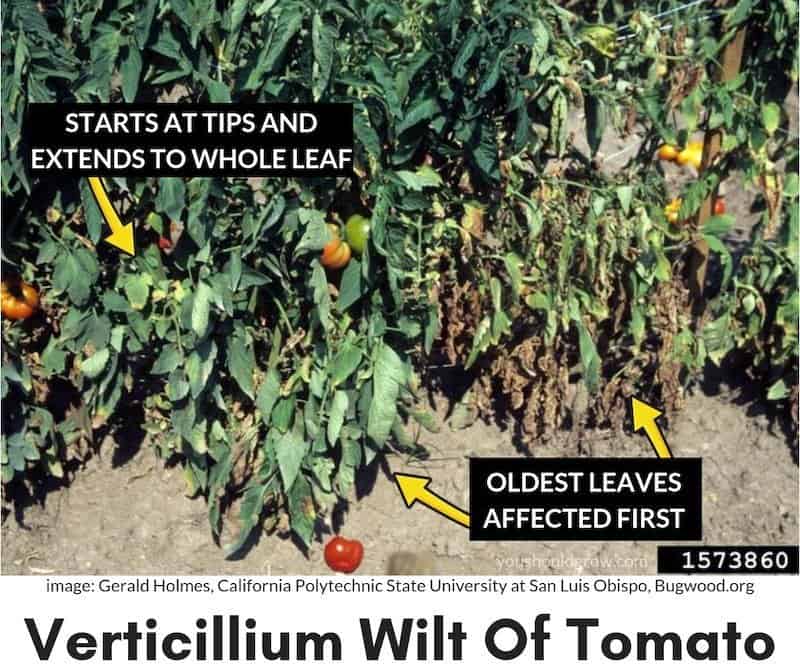
Verticillium wilt is very similar to fusarium wilt, but is more common in the north and favors cool moist soils. Verticillium wilt does not kill tomato plants but rather causes a drastic decrease in vigor and production.
Symptoms appear later in the season and include yellow discoloration of the older (lower) leaves of the plant. On the leaf, yellowing often begins in a v-shape and eventually extends to the whole leaf. The plant will wilt during the day but recover at night. Fruit may set but are smaller and fewer in numbers.
Both Fusarium and Verticillium will be evident if you cut open the stem of affected plants. You’ll see a brown to black discoloration of the vascular system whereas a healthy stem is only shades of green.
While there are ways to tell the difference, it can be very difficult to distinguish between verticillium and fusarium wilt in the field. So if you want to know which your property is affected with, you’ll need to send your plants to your local university extension office.
Like Fusarium, once verticillium is established in the soil, it will remain indefinitely. There is no way to treat or prevent infection so the only course of action is to plant resistant varieties (look for resistance label V) or plant in new containers and soil. Don’t compost – destroy infected plants
Bacterial Wilt
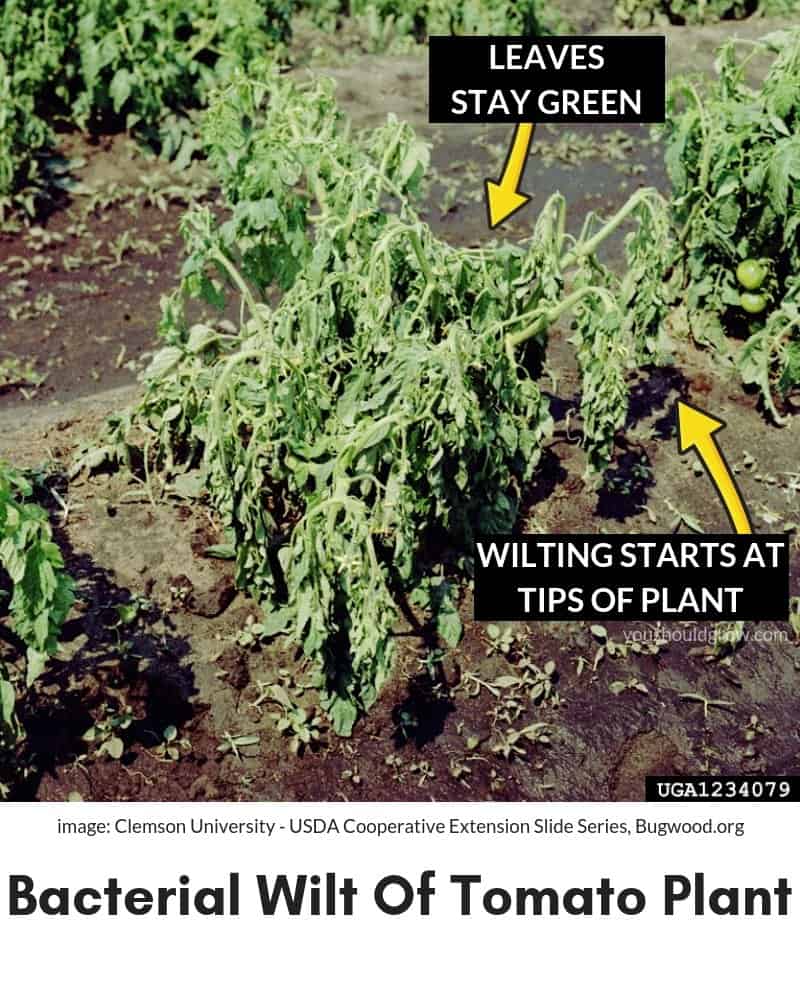
Caused by the bacterium Ralstonia (Pseudomonas) solanacearum, bacterial wilt works in the same way as the fungal wilts. The bacteria grow in and lead to the death of tomato plants. This bacteria thrives in hot and wet soils and once established remains infective for many years.
Bacterial wilt can be distinguished from other forms of wilt at home. Compared to the fungal wilts, bacterial wilt causes wilting of the youngest (uppermost) leaves. Leaves do not turn yellow but rather stay green. When you cut the stem of tomato plants infected with bacterial wilt, you’ll see a white milky substance instead of the brown growth of the fungi.
When freshly cut stems are placed in a glass of water, you can see the white substance draining from inside. If you notice these symptoms and suspect your plant is infected with bacterial wilt, pull it out of the garden right away and dispose of it. Don’t compost – destroy infected plants.
The only method of control for bacterial wilt is planting resistant varieties or grafted plants on resistant rootstock. There is no treatment for infected plants or soil. If you confirm the presence of bacterial wilt in your garden, you’ll do better to plant tomatoes in containers from now on.
Root knot Nematodes
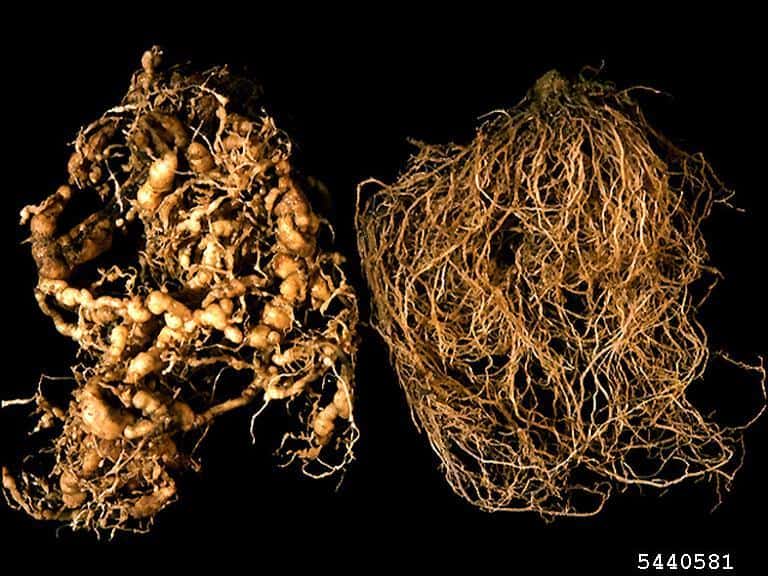
Nematodes are tiny wormlike creatures that infest and feed on tomato roots. Their presence causes knots or galls of the roots and damages their ability to take up food and water. Symptoms of root knot nematodes include wilting, stunted growth, and pale color. You’ll also see the knots or galls on the roots of the plants.
You can find tomato varieties that are resistant to nematodes as indicated by the letter ‘N’ after the variety name. Nematode numbers can be decreased by growing resistant varieties for several seasons. However, when susceptible varieties are then planted, numbers of nematodes will rise again.
Also affects pepper, cucumber, squash, eggplant, and okra.
Southern Blight
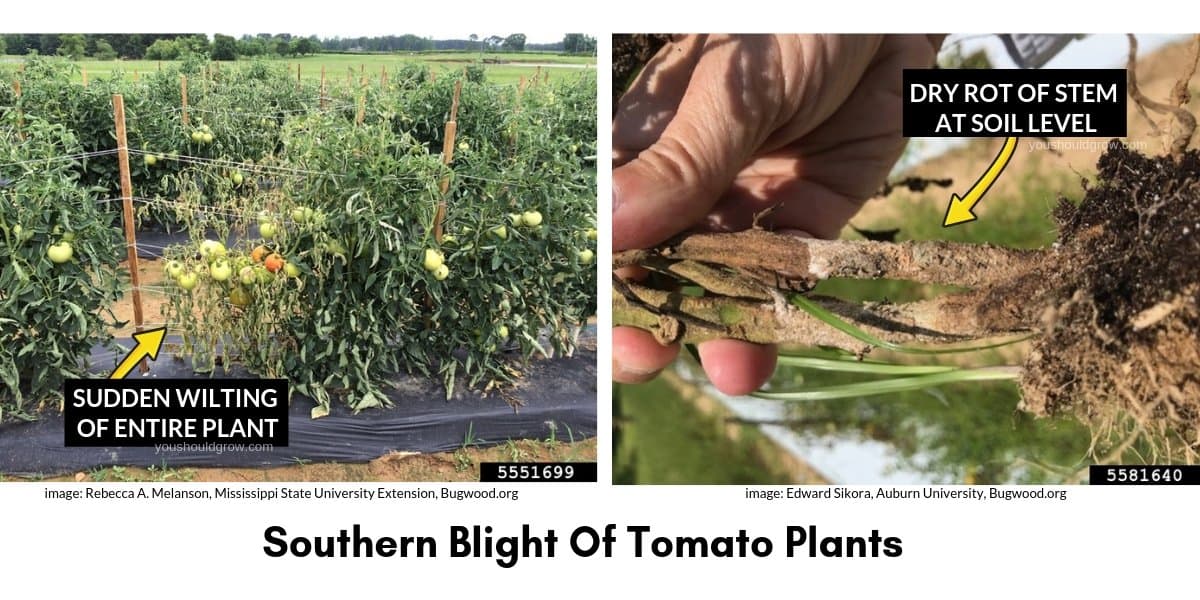
Another fungal disease, southern blight causes sudden wilting and death of the entire plant. Also known as Southern Wilt and Southern Stem Rot, the fungus enters the stem at the soil line causing the plant to suddenly wilt and die. Infection leaves a telltale dry brown rotten spot around the base of the stem which may develop a white moldy growth in high moisture situations.
The fungus lives in the top 2-3 inches of soil and high temps and wet, acidic soils encourage growth. Once the fungus is established in the soil, it can be hard to get rid of it. Grow tomatoes in raised beds or containers or grow nonsusceptible crops (corn and cover crops) for a minimum of 2 years before planting tomatoes in that area again.
Dealing with tomato wilt
Beyond optimizing your watering schedule, the best recourse for dealing with tomato wilt is to plant resistant varieties. Look for resistance label VFN, and keep in mind that many resistant tomatoes are hybrids…and it’s okay to grow hybrids even in an organic garden.
Some of my favorite wilt-resistant tomatoes are:
- Sungold
- Big Beef
- Polbig
But there are several options for you to look through at Johnny’s seed supply.
Have you lost tomato plants to tomato wilt disease?
Tell us about your experience in the comments below.
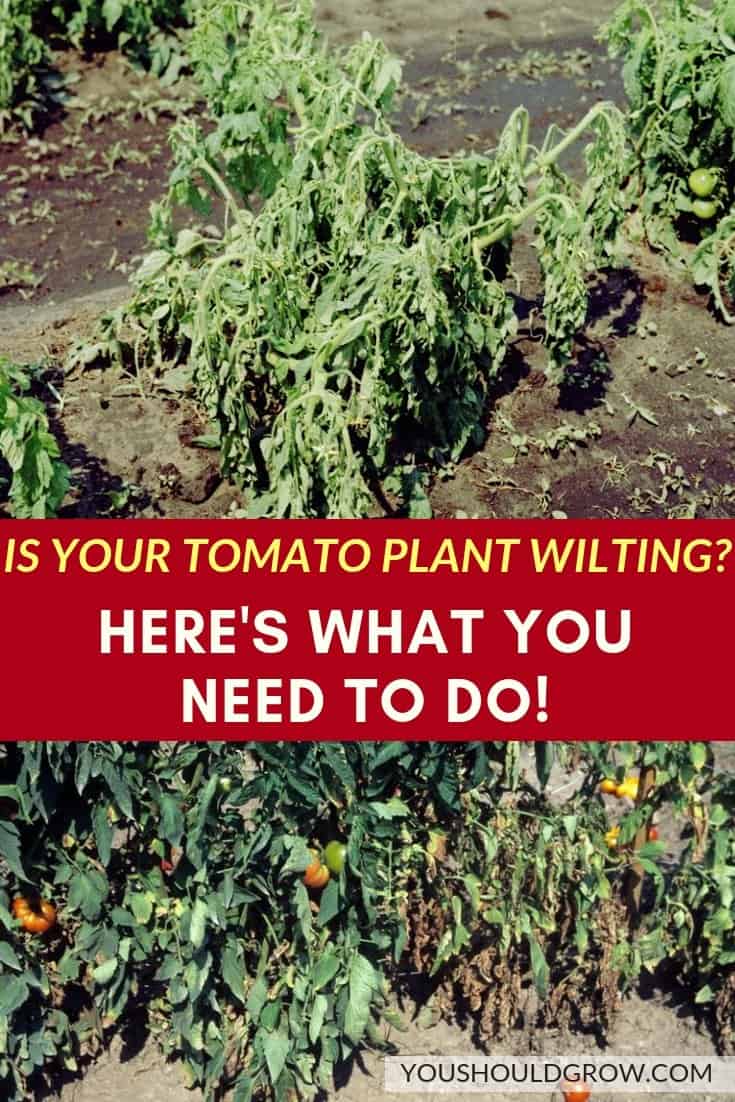
This post was updated on 12/24/22 to improve format


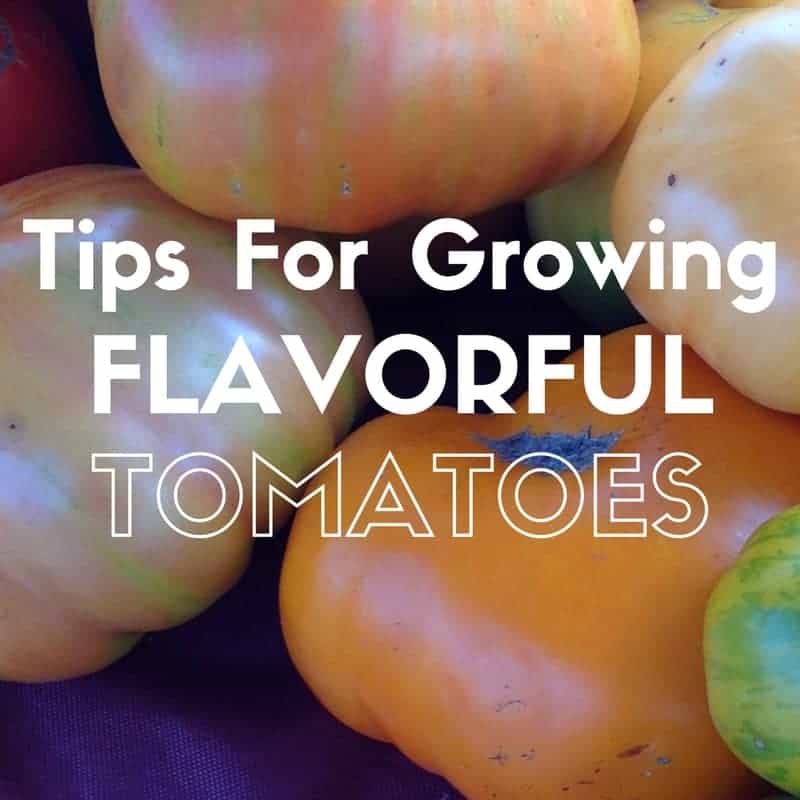
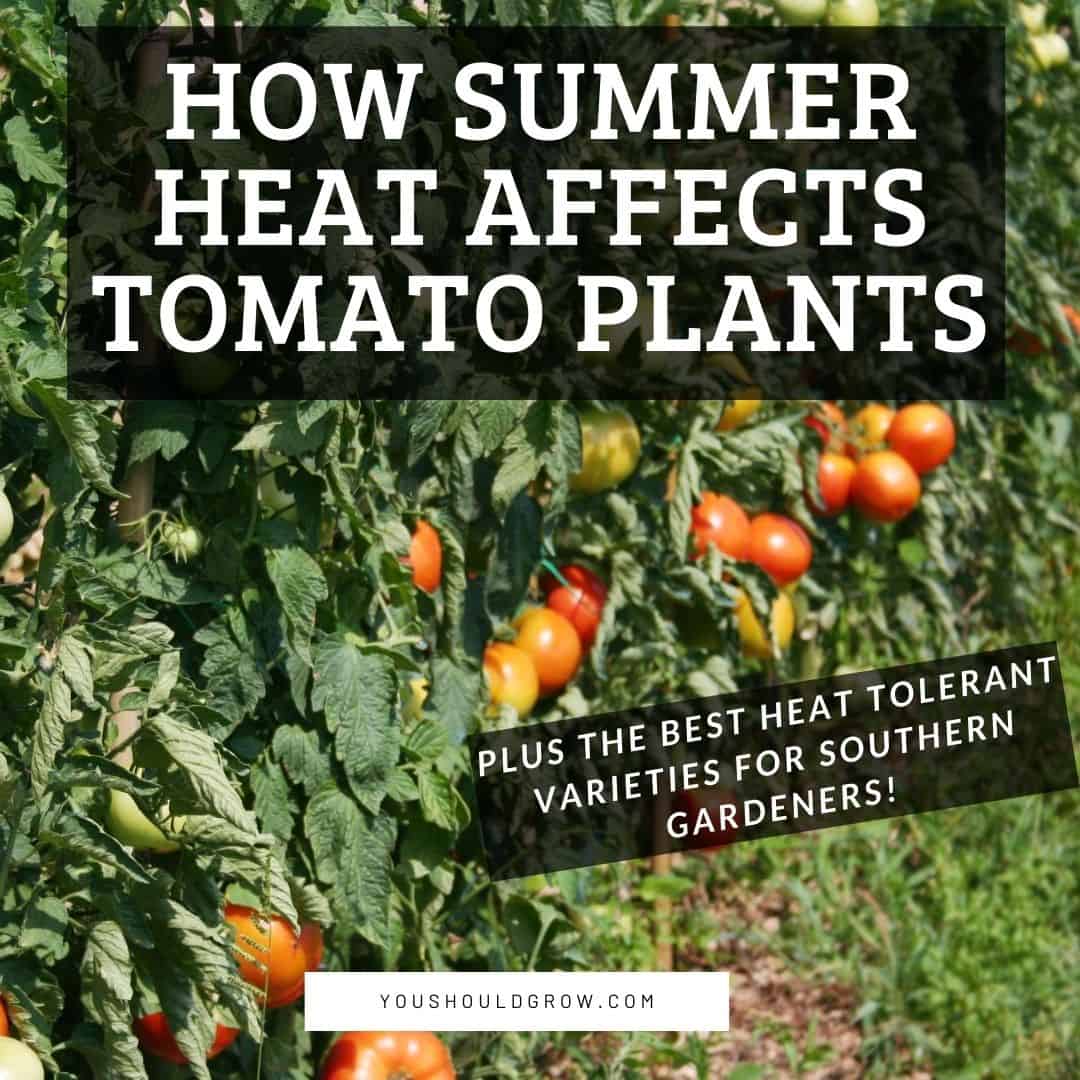

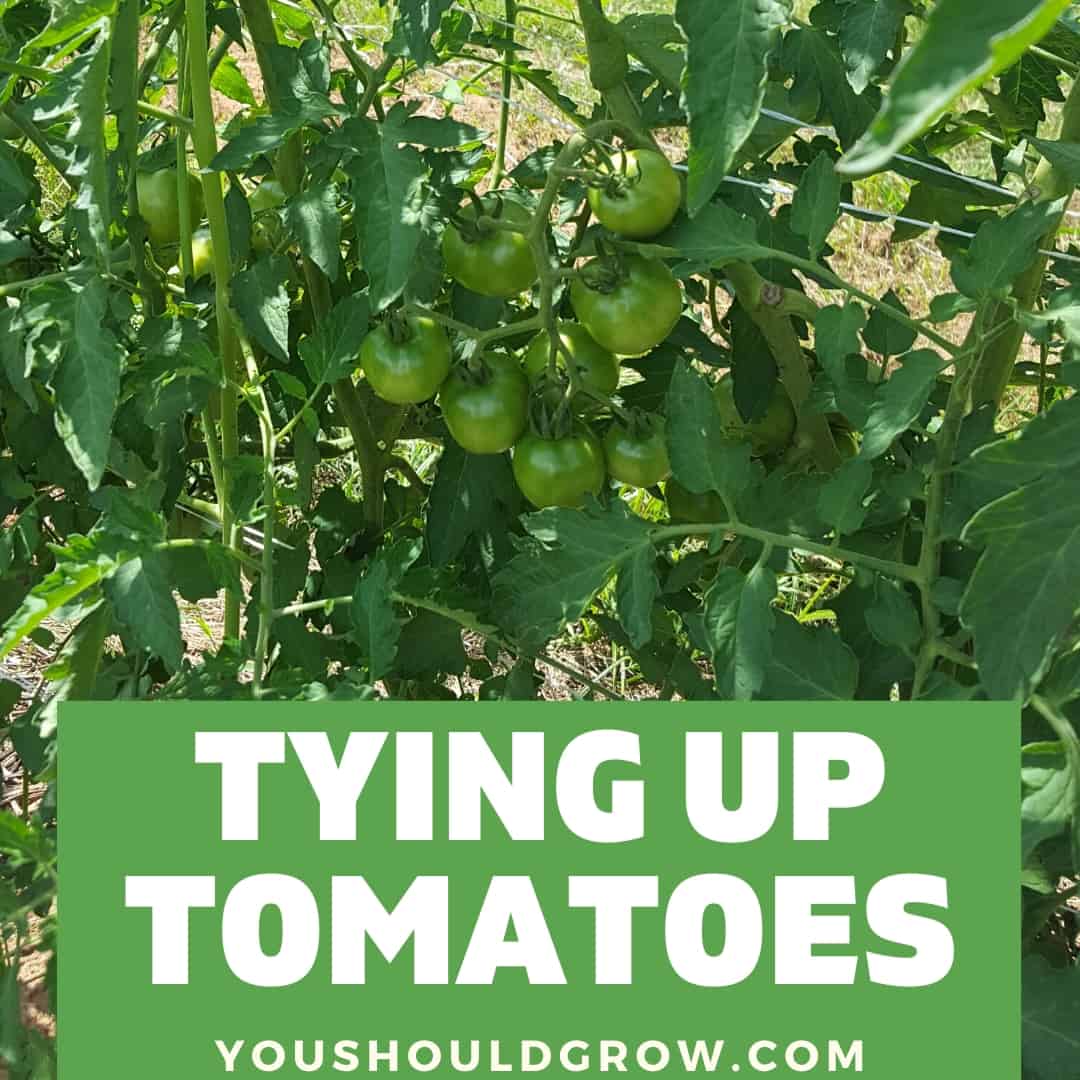
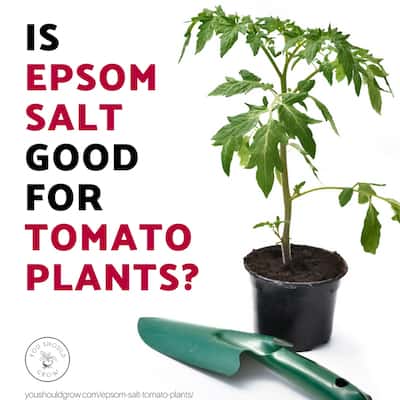
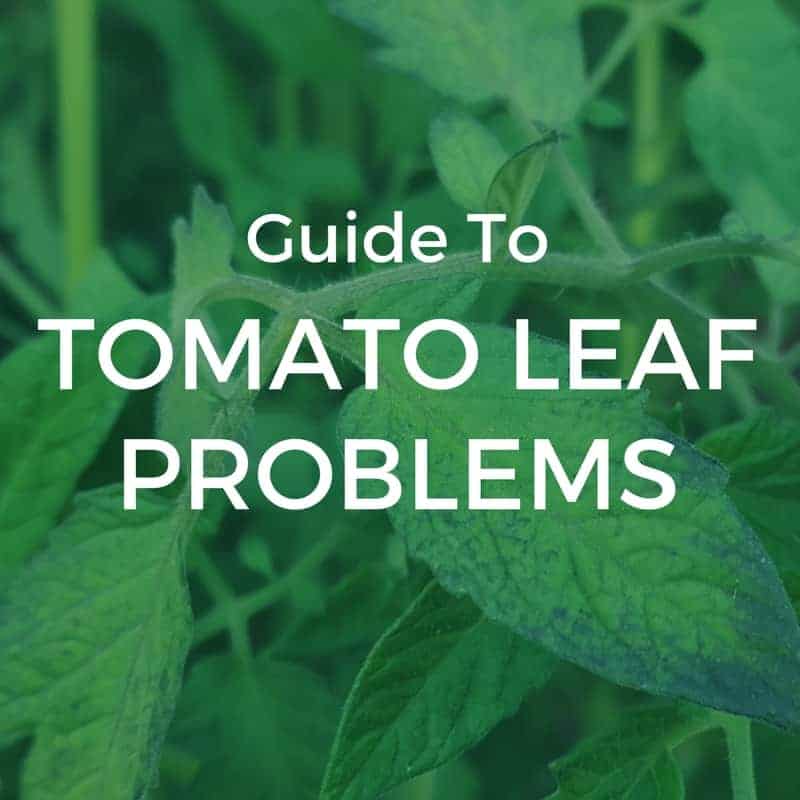
My tomato plants appear totally wilted. I pulled them out, split the main trunk and some stems. There appeared to be moisture. Placed the stems in water and nothing oozed out. This wilting affected a squash plant near by, also. I checked for nematodes, found none. The plant wilted from top to bottom. Leaves are still green without curling. This happened in a matter of two days. The plants were 3-4 feet high, with small tomatoes. I can’t find anything from research.
Karen my tomatoes are doing the same thing. Have you found anything out about what is causing this? I am thinking it is a bacterial wilt. So frustrated and disappointed. My tomato “crop” is history this year 🙁
I’m having the same problem. Big, healthy tomato plants are wilting. They are still very green, just starting to flower. 2 different varieties. I can’t find any other symptom other than they are wilting.
This happened to me. It turned out that even though I was watering thoroughly a couple of minutes a plant…twice…the mulch was absorbing the water and the mud stayed completely dry. I found out when I was applying some Good Guys Nematodes. I thought maybe it was because there were root damaging nematodes in the soil and after I watered thoroughly that day 3 times in an hour to saturate the ground as per instructions…I pulled back the mulch to apply the nematodes and was shocked that the mud was bone dry. 🙁 I lost many plants because of this. I pulled the plants because I did not want them infecting others if it was a disease before I learned about the water. From now on I will apply water with a soaker hose end straight on the mud. I’m going to research some less absorbent mulches and see if that helps. I had wood chips and in some areas pine straw. Both kept the water from getting to the soil. I know this is old comment but people may research and read this and pull back their mulch in time…
If nothing else, it may have saved my tomatoes this year. I was planning to mulch later. Now I’ll think it through.
I have a raised bed with 5 tomato plants in it. One of the plants did just what you’re describing….I pulled it out and am going to try soil solarization in that area of the bed….hope I can kill the bacteria or fungus before it spreads…..
i have lost 7 plants this year with wilt most seem to be rotting at soil level. . how do i recover from this do i need to get rid of all the soil down to about a foot and new soil for next year . i only use one side for tomatoes will the other side be afected
I would start by sending in a sample to your county extension office for testing. They’ll be able to tell you the exact disease and give recommendations. Sometimes, the only way to recover is to grow plants resistant to the disease.
Looks like I have bacterial wilt going on on my best, largest motomaro plant. Just watered yesterday and wilting at the top. It’s in a container, brand new soil. I do have a few tomatoes on it. I hope it’s able to produce some fruit.
I extended my raised bed garden and purchased top soil from a garden center by the yard. With 2 rows of 5 tomato plants each a middle plant started wilting on several branches of leaves. No browning, stem and tomatoes seemed healthy. It has spread to nearby plants in the same row. Can I do anything to improve soil? How far from the walnut does it need to be also? MI garden.
I don’t have enough information to answer your wilting question here, but regarding the walnut tree you don’t want the leaves, nuts, or roots in contact with your vegetable plants.
I accidentally put some raked black walnut leaves on my garden last fall. I tried to pick them out but may have missed some. Now my tomato plants are wilting from the top branches just as they are starting to bear fruit. Would a lab be able to identify black walnut?
i gave some miracle-gro to my young tomato plants before planting, now they don’t look so good they look wilted will they come back to normal soon, i hope so. thank bob
This morning my cherry tomatoes were fine and around 3pm I check them and the plant was completely wilted form the middle up watering and soil condition are fine I don’t understand why it happened i thought it was the heat,so I watered them and put one of those weed barrier to block the blasting heat
I’m growing tomatoes in State College, PA on an outside south eastern facing slope. Which is directly sunlit from 10:30 a.m. until 5:30 p.m. The Fusarium wilt I’m seeing is on the lowest 1/3 portion of the plants leaves. I’m going to use a fungicide on the above ground container plants and see if the condition improves. My growing medium is 2 1/2 gallons of 1/4 perlite, 1/4 composted cow manure, and 1/2 peat moss
I believe the bagged soil is the culprit. This soil from Walmart
, bagged in plastic (about 40#) and around $11. My young plants from seed were doing well, until repotted to 4 inch containers. That soil was like swamp dirt, so watery , with wood chunks throughout. The container bag probably soured with moisture and sun beating down as it sits stacked on the pallets. So disappointing, all that work, and 35 plants later have either died or soon will. Waste of time. Blame the soil people! Now we get to worry about traces of that product developing for more years to come. Bummer.
Same problem as most of the above. Start my plants indoors early April. Have great root system when I plant them in early May. Past two years they begin wilting when the plant is about three feet tall with tomatoes on them. Tomatoes will ripen as the plant dies. Farmed for fifty years and never had this problem untill a couple of years ago.
First year this is happening to me, right now. I had to be away from home for a few weeks and when I returned one plant look a bit shriveled and wilted so I took care to give it plenty of water. It seemed to perk up a bit so I’ve been keeping an eye on it. It still doesn’t look too great. Then I noticed the one next to it showing some of the same signs, leaves small and tight and curling at edges. Today I noticed the one next to that one doing it! This must be something in the soil. The remaining plants are thriving, but I fear this will spread. I’m loathe to tear them out, esp. if the culprit is in the soil and the rest of the plants are already doomed. Giving them a soak right now and hoping for the best. The two plants that are seriously in trouble are Early Girl, and I’ve never had trouble with them before.
How about a squirt of Ivermectin Horse Paste in a 5 gallon bucket of water. Heck, it seems to curing everything else on the planet.
Disclaimer: I’m not serious just disgusted at my tomato plants this year.